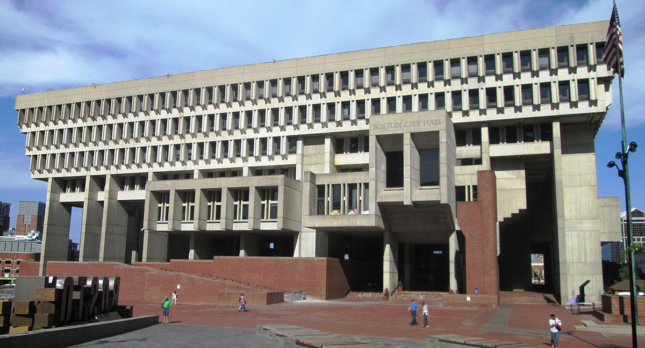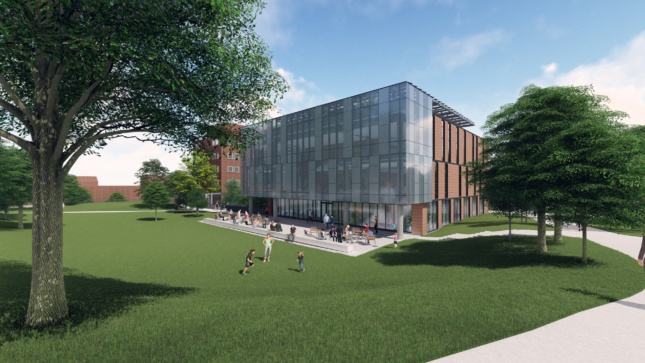On June 25, Facades+ is returning to Boston for the fourth year in a row. The conference, organized by The Architect’s Newspaper, is a full-day event split between a morning symposium and an afternoon of workshops led by top AEC practitioners. Leers Weinzapfel Associates (LWA), a Boston-based firm with projects nationwide, is co-chairing the conference.
Panels for the conference will focus on the changes underway in Boston, ranging from new educational structures, the city’s new tallest residential building, and historic preservation projects.
Participants for the conference’s symposium and workshops include Behnisch Architekten, Knippers Helbig Advanced Engineering, Pei Cobb Freed & Partners, Bruner / Cott, Arrowstreet, Consigli Construction, Walter P. Moore, Autodesk, Atelier Ten, Harvard GSD, the Wyss Institute, and Okalux.
In this interview with The Architect’s Newspaper, LWA’s designer and business development representative Zhanina Boyadzhieva and associate Kevin Bell, the conference co-chairs, discuss their firm’s growing body of work and the developmental trends within the city of Boston.
The Architect’s Newspaper: Boston is known as a relatively quiet city with a predominantly low-slung skyline. How is current development reshaping that identity and what does it mean for the future?
Zhanina Boyadzhieva: Boston is indeed a “quiet” city, but it is also a hub of innovation and creative thinking. In the past few years, we have observed dynamic design work, largely by local firms, on several fronts: 1) creative re-envisioning of historical landmarks through readaptations and additions such as Smith Center at Harvard University and Congress Square in downtown Boston 2) careful insertions of new landmarks in the skyline such as One Dalton 3) fast development and growth of existing or new resilient neighborhoods such as Harvard’s Allston campus. Each design solution addresses unique urban conditions and entails holistic thinking about city planning, resilience, and sustainability, coupled with a sense of function, form, materiality, and human experience.

Naturally, facades combine all of these considerations and become dominant players in the reshaping of cities. The diversity of approaches we observe—controlled material juxtapositions of old and new, sculptural form-making, and playful screening strategies—are testaments to ongoing design experimentations here. There is a search for new methods to address creative reuse, high performance, material fabrication, and user experience.
AN: The city possesses one of America’s largest concentrations of brutalist buildings, as well as large historic districts. How can Boston embrace its heritage while moving forward?
Kevin Bell: The rich building history of Boston, including modern landmarks like City Hall, and its brutalist companions make for wonderful urban fabric for intervention and a great place for an architect to practice. This history should serve to elevate our expectations for new buildings and major renovations in the city. The recent warming to Boston’s brutalism, its strong geometry and bare materials, is welcome, encouraging designers to consider rather ignore these local icons.

It presents the opportunity to consider adaptation and re-envisioning through sustainability’s lenses, the human experience, and materiality. If we can dramatically improve the energy efficiency and human use in these sensitive historic buildings, we can achieve the same in new construction and create a model for continued improvement.
AN: What innovative enclosure practices is LWA currently executing?
KB: As a firm, we have a legacy of designing efficiently in an urban context. Often, our site is an existing historic building or a tightly constrained sliver of land, or sometimes, there’s no site at all. This fosters a sensibility within the studio toward compact volumes, materially efficient, with taut fitted skins, a practice that serves us well as we work to make evermore energy efficient and sustainable buildings. We’re also redefining our performance expectations around our clients’ commitments to energy efficiency, many of whom have established operational carbon neutrality as their aim by mid-century. The enclosures we design today will be part of that efficiency equation. They must be considered to be part of a carbon neutral organizational environment as a performance baseline above simple compliance with today’s codes or target certifications. Envelope performance, especially the use of innovative glazing materials, is a logical extension of the way we think about reactive, efficient space and energy efficiency targets in building enclosure design.

Our Dartmouth Dana Hall renovation and addition, under construction now, is an example of this process and practice. We worked closely with the college to define a program for building reuse around its energy use reduction targets that dramatically improved envelope efficiency. Through the design process, we worked with our design and construction partners to continually refine the design while holding to incremental improvement in energy efficiency at each step; our modeled efficiency improved even as we moved through cost reduction exercises. The result is a highly insulated building, triple glazed throughout, with a thermally improved, south-facing glass curtainwall system combining vacuum insulated high-performance glass modules with integrally solar shaded, triple glazed vision glass as part of a building with a predicted energy use index (pEUI) in the middle twenties before the introduction of site renewables.
AN: Which materials do you believe are reshaping facade practices?
ZB: Materials are the agents of larger design strategies shaping the practice such as resilience, sustainability, and human experience. The aim to rethink and cherish historical buildings, for example, leads to a careful layering of existing and new materials that contrast and simultaneously enhance each other. Heavy textured concrete at the Smith Center is supplemented by light and open transparent glass, green walls and warm wood. Traditional brick block at Congress Square is juxtaposed with a floating glass box on top of sculptural fiber-reinforced plastic panels.

On the other hand, the vision to create new landmarks that celebrate and reshape the Boston skyline result in the careful sculpting of distinctive volumes as in One Dalton, a tall glass skyscraper with careful incisions of exterior carved spaces for human use. Finally, the goal to produce energy efficient but playful envelopes leads to a game of patterns composed of an inner insulated layer with an outer wrapper of perforated metal screens or angled aluminum fins. Each choice of material and its manipulation reflects a larger vision to create a unique experience in the city.
Further information regarding Facades+ Boston can be found here.












